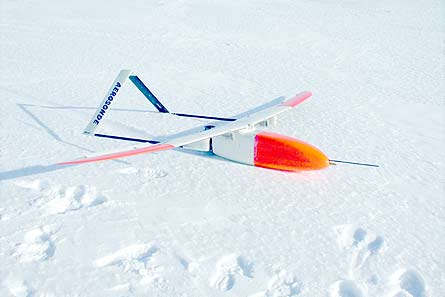The Memorial University of Newfoundland-led Remote Aerial Vehicles for ENvironment Monitoring (RAVEN) project has conducted initial flight testing of an AAI Aerosonde Mk2 unmanned air vehicle (UAV) modified to carry a micro-synthetic-aperture radar (SAR).
The test flights, carried out from mid-November to mid-December, mark the first deployment of a SAR payload aboard an Aerosonde system.
Preparations are now underway for a demonstration of sea-ice monitoring off the eastern Canadian coastline in late February and March using the mini-SAR aboard an Aerosonde Mk4.2 UAV.
The ice survey will be carried out in the vicinity of Trinity and Bonavista Bays off the Newfoundland coast, and will replicate work normally conducted by manned aircraft.
|
|---|
Aerosonde has an extensive history of Arctic operations on behalf of US science agencies |
Depending on results, the Raven consortium is considering development of a low-cost commercial maritime sensing and surveillance business. That initiative would see the Aerosonde payload suite expanded to include simultaneous carriage of micro-SAR, electro-optic sensors, and a miniaturised ship automatic identification system receiver.
Raven is a collaborative research project between Memorial University; St John’s-based Provincial Airlines, the Canadian National Research Council’s Institute for Aerospace Research and Institute for Ocean Technology; Carleton University; the University of New Brunswick, and Defence Research and Development Canada.
AAI provided air operations support for the initial flight test programme, but that role will be taken over by Provincial Airways during the coming demonstration.
Project financing is being provided by the Canadian Atlantic Innovation Fund and the Natural Sciences and Engineering Research Council of Canada.
The project has been underway for some three years and initially included development of a purpose built, low altitude, long-endurance UAV. That approach was dropped in 2005 however in favour of using an Aerosonde system once it became clear the SAR payload would be sufficiently small to fit aboard that aircraft type.
Initial flight testing of the sensor aboard an Aerosonde was planned for September last year but was delayed due to difficulties negotiating US approvals for transfer of an air vehicle to Canada under its international trafficking in arms regulations (ITAR).
The micro-SAR, which weighs less than 2kg (5lb), has been developed by Brigham Young University in Utah and the University of Colorado. The RF electronics module, the heaviest component of the system, weighs 900g (31oz).
The radar operates at 5.56Ghz with transmission power totalling less than 1W. Data generated during surveillance operations is stored on board the UAV using dual 1Gb flash memory cards, which combined can support 50min of recording.
The SAR radome is a flat-panel array measuring 127x330mm (5in x 13.2in), and is attached to one of the two tail-booms on the Aerosonde. The flight testing programme has included assessment of the impact of the radome on the UAV’s stability and performance characteristics.
Simulation-based analysis of the modified UAV carried out by the Raven team prior to the test flights indicated some impacts on centre of gravity, changes to longitudinal stability, and increased susceptibility to cross winds. That resulted in decisions to conduct the initial test flight using an Aerosonde Mk 2 rather than the more sophisticated M 4.2.
The SAR itself was flight-tested in the survey role during March 2006 aboard a Cessna 172 operated over sea-ice near Barrow Island, Alaska with no radome over the antenna array. Those flights, in conditions where outside air was down to -43°C (-45°F), saw generation of 2m resolution imagery from an altitude of 500ft (150m) at an airspeed of 72kt (133km/h).
Barrow Island is regularly used as a base of operations by Aerosonde in conjunction with the University of Colorado to carry out Arctic environmental monitoring missions using electro-optic and atmospheric-sampling sensors. That monitoring programme is funded by the US National Science Foundation.
Follow-on SAR flight trials were also held in September at Logan, Utah, with the SAR carried by a Piper Cub. Separate ground-based trials, the first conducted with a sheath radome for the antenna, were carried out at Quidi Vidi Lake on the eastern end of the island of St John's, Newfoundland that same month.
Planning for the development of a commercial services system by the Raven consortium has included consideration of a geo-referencing capability for radar images, along with development of a motion-compensation system to improve imagery clarity and introduction of an automatic target identification capability via the introduction of an enhanced on-board data processing system.
Potential integration of a datalink to enable direct transfer of imagery has also been looked at, with both line-of-sight and beyond-line-of-sight options being considered.
Source: FlightGlobal.com
























